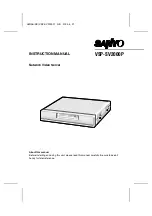
SCOPE
Spinpoint M8U-Internal Product Manual REV 3.4
2
1.3 USB
A USB system has an asymmetric design, consisting of a host, a multitude of downstream USB ports, and
multiple peripheral devices connected in a tiered-star topology. Additional USB hubs may be included in
the tiers, allowing branching into a tree structure, subject to a limit of 5 levels of tiers. USB host may have
multiple host controllers and each host controller may provide one or more USB ports. Up to 127 devices,
including the hub devices, may be connected to a single host controller.
USB supports three data rates:
A Low Speed (1.1, 2.0) rate of 1.5Mbit/s (187.5kB/s) that is mostly used for Human Interface Devices
(HID) such as keyboards, mice, and joysticks.
A Full Speed (1.1, 2.0) rate of 12Mbit/s (1.5MB/s). Full Speed was the fastest rate before the USB 2.0
specification and many devices fall back to Full Speed. Full Speed devices divide the USB bandwidth
between them in a first-come first-served basis and it is not uncommon to run out of bandwidth with
several isochronous devices. All USB Hubs support Full Speed.
A Hi-Speed (2.0) rate of 480 Mbit/s (60 MB/s).
1.4 Reference
For additional information about the USB interface, refer to:
•
USB 0.7: Released in November 1994
•
USB 0.8: Released in December 1994
•
USB 0.9: Released in April 1995
•
USB 0.99: Released in August 1995
•
USB 1.0 Release candidate: Released in November 1995
•
USB 1.0 (1.5Mbit/s, Low-Speed and 12Mbit/s, Full-Speed): Released in January 1996
•
USB 1.1: Released in September 1998
•
USB 2.0 (480Mbit/s, Hi-Speed): Released in April 2000
For introduction about USB interface please refer to:
•
Universal Serial Bus (USB*) Overview (URL:
http://www.intel.com/technology/usb/index.htm
)
•
USB Implementers Forum, Inc (URL:
http://www.usb.org
)
•
USB 2.0 Specification (URL:
http://www.usb.org/developers/docs/
)
•
FireWire vs. USB2.0 (URL:
http://www.qimaging.com/support/downloads/documents/FirewireUSB.pdf
)











































